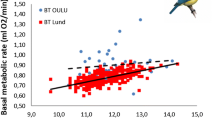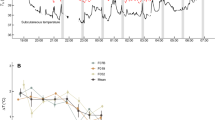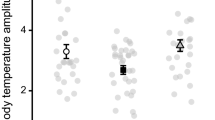Abstract
Birds commonly use rest-phase hypothermia, a controlled reduction of body temperature (T b), to conserve energy during times of high metabolic demands. We assessed the flexibility of this heterothermic strategy by increasing roost-site temperature and recording the subsequent T b changes in wintering blue tits (Cyanistes caeruleus L.), assuming that blue tits would respond to treatment by increasing T b. We found that birds increased T b when roost-site temperature was increased, but only at low ambient temperatures. Moreover, birds with larger fat reserves regulated T b at higher levels than birds carrying less fat. This result implies that a roosting blue tit maintains its T b at the highest affordable level, as determined by the interacting effect of ecophysiological costs associated with rest-phase hypothermia and energy reserves, in order to minimize potential fitness costs associated with a low T b.


Similar content being viewed by others
References
Boyles JG, Dunbar MB, Storm JJ, Brack V (2007) Energy availability influences microclimate selection of hibernating bats. J Exp Biol 210:4345–4350
Broggi J, Koivula K, Lahti K, Orell M (2003) Seasonality in daily body mass variation in a hoarding boreal passerine. Oecologia 137:627–633
Cooper SJ, Gessaman JA (2005) Nocturnal hypothermia in seasonally acclimatized mountain chickadees and juniper titmice. Condor 107:151–155
Geiser F, Ruf T (1995) Hibernation versus daily torpor in mammals and birds—physiological variables and classification of torpor patterns. Physiol Zool 68:935–966
Hake M (1996) Fattening strategies in dominance-structured greenfinch (Carduelis chloris) flocks in winter. Behav Ecol Sociobiol 39:71–76
Krams I, Cirule D, Suraka V, Krama T, Rantala MJ, Ramey G (2010) Fattening strategies of wintering great tits support the optimal body mass hypothesis under conditions of extremely low ambient temperature. Funct Ecol 24:172–177
Lane JE, Brigham RM, Swanson DL (2004) Daily torpor in free-ranging whip-poorwills (Caprimulgus vociferus). Physiol Biochem Zool 77:297–304
Larkin JE, Heller HC (1999) Sleep after arousal from hibernation is not homeostatically regulated. Am J Physiol 276:R522–R529
Laurila M, Hohtola E (2005) The effect of ambient temperature and simulated predation risk on fasting-induced nocturnal hypothermia of pigeons in outdoor conditions. J Therm Biol 30:392–399
Lessells CM, Boag PT (1987) Unrepeatable repeatabilities—a common mistake. Auk 104:116–121
Maddocks TA, Geiser F (1997) Energetics, thermoregulation and nocturnal hypothermia in Australian silvereyes. Condor 99:104–112
Martin LB, Weil ZM, Nelson RJ (2008) Fever and sickness behaviour vary among congeneric rodents. Funct Ecol 22:68–77
McKechnie AE, Lovegrove BG (2002) Avian facultative hypothermic responses: a review. Condor 104:705–724
McKechnie AE, Lovegrove BG (2003) Facultative heterothermic responses in an Afrotropical arid-zone passerine, the red-headed finch (Amadina erythrocephala). J Comp Physiol B 173:339–346
McNab BK (2002) The physiological ecology of vertebrates: a view from energetics. Cornell University Press, Ithaca
Merola-Zwartjes M, Ligon JD (2000) Ecological energetics of the Puerto Rican tody: heterothermy, torpor, and intra-island variation. Ecology 81:990–1003
Millesi E, Prossinger H, Dittami JP, Fieder M (2001) Hibernation effects on memory in European ground squirrels (Spermophilus citellus). J Biol Rhythm 16:264–271
Nord A, Nilsson JF, Sandell MI, Nilsson J-Å (2009) Patterns and dynamics of rest-phase hypothermia in wild and captive blue tits during winter. J Comp Physiol B 179:737–745
Palchykova S, Crestani F, Meerlo P, Tobler I (2006) Sleep deprivation and daily torpor impair object recognition in Djungarian hamsters. Physiol Behav 87:144–153
Pravosudov VV, Lucas JR (2000) The costs of being cool: a dynamic model of nocturnal hypothermia by small food-caching birds in winter. J Avian Biol 31:463–472
Pravosudov VV, Grubb TC, Doherty PF, Bronson CL, Pravosudova EV, Dolby AS (1999) Social dominance and energy reserves in wintering woodland birds. Condor 101:880–884
Reinertsen RE (1996) Physiological and ecological aspects of hypothermia. In: Carey C (ed) Avian energetics and nutritional ecology. Chapman & Hall, New York, pp 125–157
Reinertsen RE, Haftorn S (1984) The effect of short-time fasting on metabolism and nocturnal hypothermia in the willow tit Parus montanus. J Comp Physiol 154:23–28
Roth TC, Rattenborg NC, Pravosudov VV (2010) The ecological relevance of sleep: the trade-off between sleep, memory and energy conservation. Phil Trans R Soc B 365:945–959
Seber GAF, Lee AJ (2003) Linear regression analysis. John Wiley & Sons, New Jersey
Svensson L (1992) Identification guide to European passerines. British Trust for Ornithology, Norfolk
Acknowledgments
We thank R. Mark Brigham and Lars Råberg as well as the editor and two anonymous reviewers for helpful comments on a previous version of the manuscript. This study was supported by grants from the Swedish Research Council (to J.-Å.N.) and the Längman Cultural Foundation (to A.N.).
Author information
Authors and Affiliations
Corresponding author
Additional information
Communicated by Esa Lehikoinen.
Rights and permissions
About this article
Cite this article
Nord, A., Nilsson, J.F. & Nilsson, JÅ. Nocturnal body temperature in wintering blue tits is affected by roost-site temperature and body reserves. Oecologia 167, 21–25 (2011). https://doi.org/10.1007/s00442-011-1972-6
Received:
Accepted:
Published:
Issue Date:
DOI: https://doi.org/10.1007/s00442-011-1972-6




